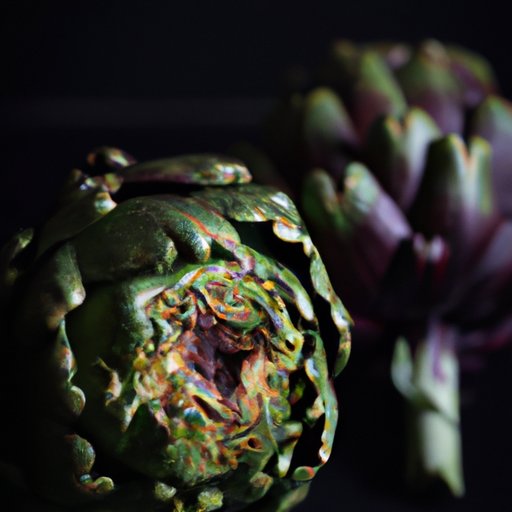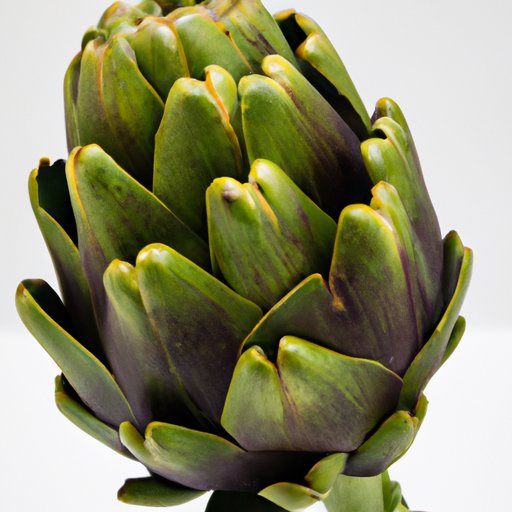
Introduction
Hello and welcome! In today’s article, we’ll explore the fascinating vegetable that is the artichoke and how to cook it to perfection. Whether you’re a seasoned cook or just starting out, artichokes are an exciting addition to any kitchen, and we’re here to guide you through the process.

Artichoke 101: The Basics of Choosing and Cooking this Delicious Vegetable
If you’ve never had the pleasure of eating an artichoke, you’re in for a treat. Artichokes are a versatile and nutritious vegetable with a unique flavor. They’re a great source of vitamins and minerals, including vitamin C, folate, and potassium.
There are several types of artichokes out there. The most common are the globe, which is the large, round one you see at the grocery store, and the baby artichoke, which is the small one. When choosing an artichoke, look for one that is heavy for its size, with tightly packed leaves that are a vibrant green color. Avoid artichokes that are wilted, brown, or have loose or damaged leaves.
The Ultimate Guide to Preparing Artichokes: From Cleaning to Cooking
Preparing an artichoke may seem intimidating, but it’s actually quite simple. First, rinse the artichoke under running water and pat dry. Next, use a sharp knife to trim the top off the artichoke, removing about an inch or so. Then, use scissors to snip the pointed tips off the leaves. You can also remove the tough outer leaves by pulling them off. If your artichoke isn’t already trimmed, slice off about half an inch from the stem.
Once your artichoke is prepared, you can choose from a variety of cooking methods. Steaming is the most common and involves placing the artichoke in a pot with about an inch of water on the bottom. Cover the artichoke and steam for about 30-45 minutes until the leaves are tender. Another option is to boil the artichoke in a pot of salted water for 20-30 minutes, or until tender. Finally, roasting is a delicious option that results in a nutty, caramelized flavor. Simply drizzle the artichoke with olive oil and roast in the oven for about an hour at 400°F.
If you don’t want to eat your artichoke whole, you can also remove the heart and chop it up to use in salads, dips, or other dishes.
Savor the Flavor: How to Enhance the Taste of Your Artichokes
While artichokes are delicious on their own, adding some extra flavor can really make them shine. One popular option is to dip the leaves in melted butter, but you can also try drizzling them with lemon juice or sprinkling them with herbs like parsley, thyme, or oregano. Artichokes also pair well with strong, savory flavors like garlic, cheese, and olives.
Discover the Best Artichoke Recipes: From Grilled to Stuffed
If you’re looking for some inspiration on what to do with your artichokes, we’ve got you covered. Whether you’re a meat lover or a vegetarian, there are endless ways to enjoy this versatile vegetable. Here are some of our favorite recipes:
- Grilled artichokes with garlic aioli
- Spinach and artichoke dip
- Artichoke and mushroom quiche
- Stuffed artichokes with breadcrumbs and parmesan cheese
- Braised artichokes with white wine and lemon
Master the Art of Cooking Artichokes with These Simple Tips and Tricks
If you’re new to cooking artichokes, don’t worry; there are a few tips and tricks to ensure success. First, don’t be afraid to experiment with different cooking methods and flavors. You may find that you prefer roasted artichokes to steamed, or that you love adding a sprinkle of red pepper flakes for some heat.
Another tip is to store your artichokes properly to prevent them from spoiling. Keep them in a plastic bag in the refrigerator, and they should last for up to a week. Finally, if you’re having trouble with tough or chewy leaves, try adding a pinch of salt to the cooking water. This can help tenderize the artichoke and make it more enjoyable to eat.
Transform Your Cooking with Artichokes: Impress Your Guests with These Gourmet Recipes
For those looking to impress guests or take their culinary skills to the next level, here are some advanced artichoke recipes to try:
- Artichoke and goat cheese tartlets
- Grilled artichokes with lemon and truffle oil
- Artichoke and pancetta risotto
- Roasted artichoke and garlic soup
Conclusion
And there you have it – everything you need to know to master the artichoke. Whether you’re a beginner or an experienced cook, this versatile vegetable is a great addition to any kitchen. So go ahead, experiment, and see what delicious creations you can come up with.





